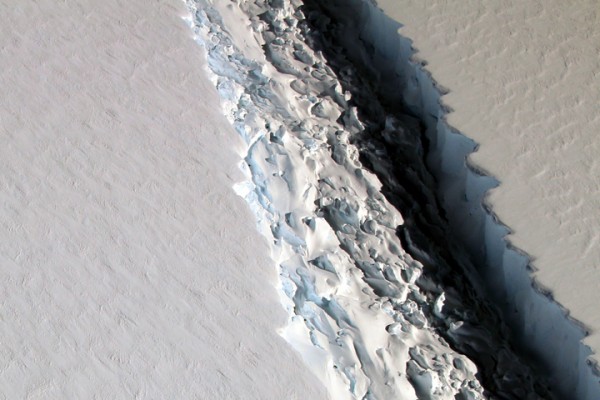By Ana Verayo, | January 09, 2017

NASA scientist John Sonntag snapped this photo on November 10, 2016, during an Operation IceBridge flight. (NASA Earth Observatory)
A massive crack on the Antarctic can result in an iceberg breaking apart from the continent, which can also lead to the collapse of a massive ice shelf, according to scientists.
An iceberg from the Larsen C ice shelf is about to break away, measuring a massive 1,900 square miles. It is now holding on to the main ice shelf with a 12-mile section of ice.
Like Us on Facebook
Scientists are monitoring this impressive crack on the ice, and it has been growing bigger in size since the middle of 2016. In December, this crack grew into a whopping 11 miles. If this iceberg continues to break away, this will become one of the top ten largest ever since record keeping began.
Icebergs that break away from their ice shelves are known as calves. When this occurs, the Larsen C ice shelf will lose 10 percent of its surface area, according to Project MIDAS, a UK-based Antarctic research project.
According to Adrian Luckman of the Swansea University in Wales, if this does not break off in a few months then that will be surprising. Researchers have predicted this calving event would occur within the next decade or earlier.
In 2002, the Larsen B ice shelf disintegrated entirely, which is Larsen C ice shelf's neighbor in the Antarctic.
NASA scientists began carrying out aerial surveys in November last year and obtained measurements of this large crack on the Larsen C ice shelf, measuring around 70 miles long and more than 300 feet across and one-third of a mile in depth.
Even if scientists have monitored the entire ice shelf for some decades now, researchers say that this crack is part of its natural evolution. However, there can also be a possible link to the planet's changing climate, yet there is still no direct evidence.
Researchers estimate that this ice calving will not directly contribute to rising sea levels. However, if the ice on the surface of the Larsen C ice shelf escapes into the ocean, there will be a 10-centimeter rise in global sea levels.
-
Use of Coronavirus Pandemic Drones Raises Privacy Concerns: Drones Spread Fear, Local Officials Say

-
Coronavirus Hampers The Delivery Of Lockheed Martin F-35 Stealth Fighters For 2020

-
Instagram Speeds Up Plans to Add Account Memorialization Feature Due to COVID-19 Deaths

-
NASA: Perseverance Plans to Bring 'Mars Rock' to Earth in 2031

-
600 Dead And 3,000 In The Hospital as Iranians Believed Drinking High-Concentrations of Alcohol Can Cure The Coronavirus

-
600 Dead And 3,000 In The Hospital as Iranians Believed Drinking High-Concentrations of Alcohol Can Cure The Coronavirus

-
COVID-19: Doctors, Nurses Use Virtual Reality to Learn New Skills in Treating Coronavirus Patients







